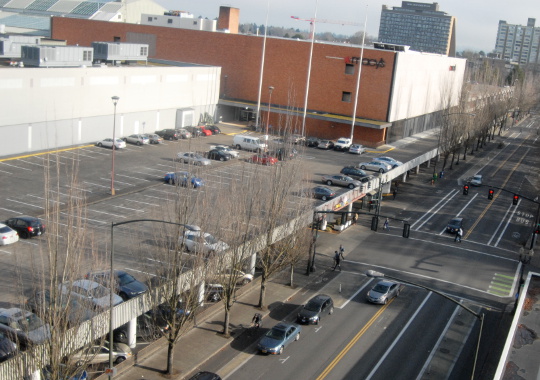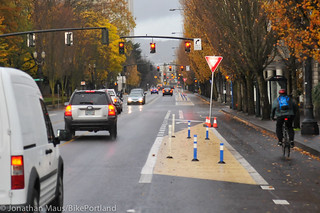
(Photo by M.Andersen/BikePortland)
The two-story parking garage that for 50 years has walled off Portland’s biggest mall could be in for change, people familiar with the plans say.
The Lloyd Center Mall’s new owners have hired a New York-based planning consultant to help imagine a new human-friendly entrance for the mall facing Multnomah Street, which Lloyd District landowners are redesigning as a major commercial corridor in the wake of a project that slowed auto traffic by replacing two general travel lanes with protected bike lanes.
“I’m very, very excited for what they want to do,” said Terry Goldman, manager of the neighboring Doubletree Hotel and an attendee of a recent meeting to discuss the plans with neighbors. “They want to make it a grand entrance. I think the asset manager for the owners, he stood up in front of the room and said, ‘Our entrance to our mall is a parking garage?'”
Portland parks manager Sue Glenn, whose job involves maintaining Holladay Park, agreed. “From the park’s perspective, it’s almost like the mall’s back is to us,” she said. “They’re really interested in opening that up.”
Dallas-based Cypress Equities bought the three-story mall for $148 million last June. There’s no public timeline yet on their plans to rethink the site, but the decision to hire Dan Biederman, founding manager of New York City’s Bryant Park Restoration Corporation, suggests that the plan is serious.
“We’re just trying to explore what will enhance the property,” Wanda Rosenbarger, the mall’s general manager, said in an interview Thursday. “The park is a huge asset.”
Rosenbarger said planners and architects considering the project aren’t sure whether or not the changes would end up reducing the total amount of auto parking at the mall, but that a new front door for the mall that faces Multnomah Street and Holladay Park is on the owners’ wish list.
Lindsay Walker of the Lloyd Transportation Management Association said the plans would fit into the neighborhood’s goals for the newly enhanced street, which also runs perpendicular to a new streetcar line and includes a few new metered auto parking spaces.
“It’d be a wonderful way to reinvigorate what’s sort of a dead space right now,” Walker said of the mall redesign concept. “One of the goals when we embarked on the Multnomah pilot project was to see more ground-level retail, invigorate the street.”
Multnomah project manager Ross Swanson said the property owners adjacent to the redesigned street will meet two to three times this spring to discuss making the protected bike lane permanent.
The mall’s proposed changes, if they happen, would join tens of millions of dollars in real estate development already planned alongside the new protected bike lane — one that drew criticism when it went in as being bad for business.
In 2012, a KATU-TV report mocked the Multnomah bike lanes as a symbol of “City Hall putting bike projects ahead of basic street repairs” under Mayor Sam Adams. (The report didn’t mention that the Multnomah project cost the city $175,000, 0.0001 percent of the city’s $1.5 billion street maintenance backlog.) Influential local blogger Jack Bogdanski predicted that the Multnomah project was part of a plan to make the area “utterly repulsive to small business.”
The opposite has been true. Wade Lange of American Assets Trust, a major local landowner preparing to redevelop 16 blocks in the area, said last year that though the bikeway certainly didn’t enable their huge projects on its own, the slower traffic speeds on Multnomah Street — caused not by any changes to the speed limit but by narrowing the lanes and adding parking — fit perfectly into creating a more walkable, comfortable and ultimately valuable commercial district.
“You slow the traffic down, you do the landscaping and you get more people walking on the streets, and suddenly the retail exists,” Lange said. “It just becomes a more active street than it ever was before … a place where pedestrians want to spend their time.”
Walker, of the Lloyd TMA, agreed.
“It’s already easier to cross,” she said of Multnomah. “It’s already a more pleasant place to be.”
— The Real Estate Beat took December off but is back for the new year with a string of big low-car development news to break. You can sign up to get an email of Real Estate Beat posts (and nothing else) here, or read past installments here. We are looking for a sponsorship partner. If interested, please call Jonathan at (503) 706-8804.


